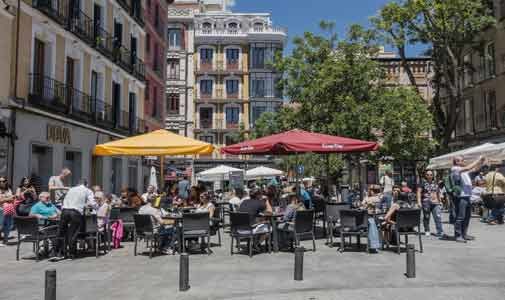My expat life in Madrid is almost perfect. The weather, wine, food, cost of living, and public transportation suit me just fine. This sophisticated city has given me a wealth of friends. Artists, actors, professors, architects, and scientists populate my social circle. I just have one small problem.
When the conversation turns to politics, aesthetics, or philosophy (as it often does), my rudimentary Spanish language skills are not up to the task.
Spanish has always had a place in my life. I’ve lived in both Los Angeles and New Mexico, where you hear Spanish in many neighborhoods. Travel and study in Mexico, Central and South America gave me more language experience. However, life in Spain has revealed how basic my skills are. My Spanish is good enough to get by. The pharmacist understands my halting question, but if his answer is more than a word or two, my response is a clueless smile and nod. Classes, private lessons, smartphone apps, and intercambios with Spaniards learning English all help.
My skills are improving little by little. But reciting verb conjugations and grasping the concept of the subjunctive tense don’t help me make small talk with my favorite bartender, much less contribute to those deeper conversations with Spanish friends.
Luckily, I discovered a way to jumpstart my fluency and comprehension: a one-day Spanish-language immersion.
This day-without-English brings together students of Spanish and native Spanish-speaking volunteers for one-on-one conversations, group activities, and social interactions. Formal grammar lessons are not part of the program. The atmosphere is casual and fun. It’s like just spending a Saturday making new friends who won’t speak a word of English.
At 10 a.m. on a Saturday, I report to an art gallery in the Chamberí district of Madrid, feeling apprehensive about my shaky Spanish skills. María Goyanes, the friendly program director, welcomes me, checks me in, and gives me a packet of materials. Elisa Sánchez, a bright young Spanish teacher, engages me in a quick conversation to determine my level. Over coffee and cookies, other students and volunteers introduce themselves. Students hail from Britain, Scotland, Switzerland, and the U.S. Many of them are English teachers in Madrid. The Spaniards are professional and retired Madrileños (Madrid locals). All are friendly, warm, and supportive.
After gathering in a conference room for orientation and more formal introductions, we are assigned different activities. My group activity is led by Elisa. She prompts me and three other students to talk about where we have traveled in Spain. Next, she asks us to write (and read) questions for an interview with our favorite celebrity. Feeling fairly successful at these tasks builds my confidence.
Next, Elisa leads us in a game. We each write eight of our favorite Spanish words on separate slips of paper and put them in a jar. In turn, we each draw a word and give clues in Spanish without using the word, while the others try to guess what it is. I’m pretty good at it and begin to feel empowered.
After a break, I have a one-on-one with Ãngela Fernández, a vibrant retired woman who tells me she’s had three husbands and a successful career in real estate. I understand most of what she says, although I stop her for clarification a few times. I tell her the basics about myself, and I’m even able to be funny. I give myself a B+.
Next is another one-to-one with Nacho Diez, an easygoing man who handles VIP tickets for the Real Madrid futbol team. He tells me about the politics of the Catalan independence referendum. I talk about U.S. politics and he understands me. The topics seem advanced, and I feel as though I’m keeping up.
The rest of the time flies by. The owner of the art gallery gives us a tour of her exhibits, which all feature young Spanish artists. The more advanced students give presentations about their home countries, as though they are promoting tourism. Their presentations are amusing and their vocabulary is basic, so I get all that.
By the time we all walk to a local bar to sit around a long table and chat in Spanish over tapas, wine, and beer, I’m feeling confident. In typical Spanish fashion, the lunch lasts two hours and overflows with conversation and friendship, todo en español (all in Spanish). Before we depart, María gives us certificates in a mini-graduation ceremony. We drift away little by little, leaving each other with the traditional two kisses and abrazos (hugs).
Even one day in immersion helps me see that, despite grammatical errors, I can communicate in Spanish fairly well. Feeing more successful makes the language experience more fun, which makes me want to learn more.
You can experience a one-day Spanish immersion the third Saturday of every month from 10 a.m. to 4 p.m. in Madrid. The cost of $80 includes a generous tapas lunch with wine or beer. For more information visit: Puebloespanol.com.
Now that I’ve gotten my feet wet, I’m ready to jump into the eight-day immersion program, Pueblo Español. I plan to spend May 11 to 18 at a luxurious resort near the medieval village of La Alberca, in western Spain, enjoying the local gastronomy and speaking entirely in Spanish. See: Puebloespanol.com/immersion-program.
Editor’s note: Uncover all the secrets to living better for less in Spain with our special manual Escape to Spain. You’ll find on-the-ground intelligence about where to enjoy a slow-paced, arts-rich life, how to earn an income (and get a long-term visa) and where to find the best, sun-splashed coastal locales…and lots more. Get your copy of Escape to Spain here

